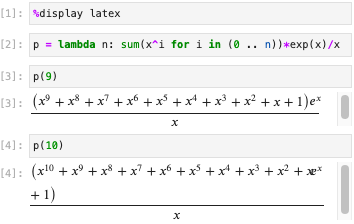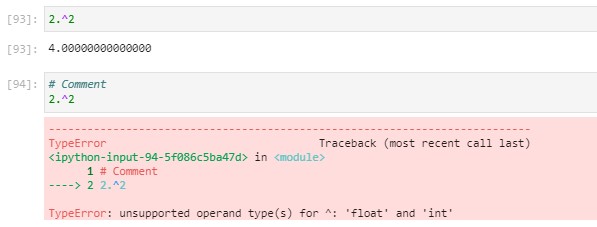Florentin Jaffredo's profile - activity
| 2023-11-21 17:37:18 +0200 | received badge | ● Famous Question (source) |
| 2023-09-16 09:13:35 +0200 | received badge | ● Notable Question (source) |
| 2023-05-19 14:27:28 +0200 | received badge | ● Popular Question (source) |
| 2023-03-09 20:18:39 +0200 | commented answer | Switching coordinate charts mid-integration with solve_across_charts Can you try without solve_across_charts? The integration is supposed to stop when exiting the chart. Are you saying it w |
| 2023-03-09 01:08:52 +0200 | answered a question | Switching coordinate charts mid-integration with solve_across_charts I am not entirely sure how to solve your issue. Indeed If I remove your chart transition, the geodesic declaration (M.in |
| 2022-10-28 13:55:04 +0200 | received badge | ● Popular Question (source) |
| 2022-10-28 13:55:04 +0200 | received badge | ● Notable Question (source) |
| 2022-08-02 10:53:04 +0200 | received badge | ● Famous Question (source) |
| 2022-04-28 18:02:15 +0200 | received badge | ● Popular Question (source) |
| 2022-04-10 18:57:43 +0200 | received badge | ● Good Answer (source) |
| 2021-12-06 16:27:28 +0200 | received badge | ● Notable Question (source) |
| 2021-05-31 19:15:04 +0200 | commented question | Computing geodesics for 4D manifold Hi ! If you define across_charts=True you need to use geod.solve_across_charts instead of geod.solve. But I don't think |
| 2021-05-14 14:27:58 +0200 | received badge | ● Nice Answer (source) |
| 2021-05-11 16:06:36 +0200 | answered a question | Geodesics/tangent vector evaluation interpolation error This is a bug, now tracked here. Thank you for reporting it. It seems there was an oversight when adding the solve_acro |
| 2021-03-31 11:56:06 +0200 | received badge | ● Good Answer (source) |
| 2021-03-30 19:04:49 +0200 | received badge | ● Nice Answer (source) |
| 2021-03-30 16:32:33 +0200 | answered a question | Integrating geodesics backwards in time Hi! Yes, it should be possible. You can find an example in this notebook. It's done by defining the initial 4-velocity |
| 2021-01-24 10:42:23 +0200 | commented question | Link between notebooks You are probably looking for the |
| 2021-01-21 10:42:38 +0200 | commented question | wsl W10 Ubuntu2004 JupyterLab future upgrade Compilation time has been improved significantly with WSL2, it's not necessarily slower than on native linux.
|
| 2021-01-06 23:34:31 +0200 | received badge | ● Nice Question (source) |
| 2021-01-06 15:18:34 +0200 | commented question | Line break in latex output makes it read wrong Because I want to display the stuff. I think a nice output makes it a lot simpler to understand a result. The latex output is usually superior to a simple print in this regard. Except when it's actively trying to confuse me, like in the first example I provided. |
| 2021-01-06 14:43:06 +0200 | commented question | Line break in latex output makes it read wrong My problem is not really to obtain a perfect "LaTeXification", If I want to copy it in a document the width will probably be different anyway, but this is just mistake inducing from me (I just lost 30 minutes this morning trying to understand this particular example, until at one point I resized the window and it went away. I was very sad...) Sorry for not providing a minimal example. Here is one: Once again, aligning the $e^x$ with the last line instead of the first would solve the ambiguity. |
| 2021-01-06 13:15:55 +0200 | asked a question | Line break in latex output makes it read wrong With For example, run for various values of
Why isn't the factor $e^x$ after the parenthesis on the second line instead? Is this even a SageMath, a Jupyter, or a MathJax issue? Where to report it? Versions: JupyterLab 2.2.9, SageMath 9.3beta4. |
| 2020-12-27 22:02:48 +0200 | commented question | Preparser not working if cell starts with a comment Looking at the code for That code has been there since at least 2014, and perfectly explains the first observation. An easy fix would probably be to check here for a line break, but that doesn't explain why it was working before. |
| 2020-12-27 21:13:30 +0200 | commented question | Preparser not working if cell starts with a comment Thanks Eric for the quick reply. The same is true for Sage 9.0. I wonder what changed, and how was it working previously. |
| 2020-12-27 19:22:28 +0200 | commented answer | Finding absolute values of roots of polynomials with Sage It probably depends on the polynomial. My guess is that it will become worse with increasing degree. One way to find the appropriate precision is to compare the result with a known root. Here for example I increase the precision in order to compute 172 in this case. |
| 2020-12-27 19:12:40 +0200 | received badge | ● Nice Question (source) |
| 2020-12-27 19:01:49 +0200 | commented answer | Finding absolute values of roots of polynomials with Sage You can always replace |
| 2020-12-27 18:49:45 +0200 | asked a question | Preparser not working if cell starts with a comment Some of my code stopped working after I upgraded from version 9.0 to 9.3beta4. I tracked it to the following bug: The code is not getting preparsed if it starts with a comment. In practice it looks like this:
This seems like a big issue, and I would be surprised if it went unnoticed until now. Could it be caused by my Sage installation? (Compiled from source on WSL2 Ubuntu 20.04, which is not officially supported, but I didn't notice anything weird). |
| 2020-12-21 00:34:37 +0200 | marked best answer | Stack overflow during symbolic manipulations I'm trying to evaluate this cursed integral (finite for $ 0 < a < 1 $): $$\int_0^1 \frac{x}{\log{\left(ax+(1-x)^2\right)}}{\rm d}x$$ using Sagemath 9.0 and 9.1: leads to Sympy gives a result even without the assumptions (which is odd by itself): $$\frac{1}{4} {\left(a^{2} + \sqrt{{\left(a - 4\right)} a} {\left(a - 2\right)} - 4 a + 2\right)} \log\left(\frac{a^{2} + \sqrt{{\left(a - 4\right)} a} {\left(a - 2\right)} - 4 a + 4}{2 {\left(a - 2\right)}} + 1\right) - \frac{1}{4} {\left(a^{2} + \sqrt{{\left(a - 4\right)} a} {\left(a - 2\right)} - 4 a + 2\right)} \log\left(\frac{a^{2} + \sqrt{{\left(a - 4\right)} a} {\left(a - 2\right)} - 4 a + 4}{2 {\left(a - 2\right)}}\right) + \frac{1}{4} {\left(a^{2} - \sqrt{{\left(a - 4\right)} a} {\left(a - 2\right)} - 4 a + 2\right)} \log\left(\frac{a^{2} - \sqrt{{\left(a - 4\right)} a} {\left(a - 2\right)} - 4 a + 4}{2 {\left(a - 2\right)}} + 1\right) - \frac{1}{4} {\left(a^{2} - \sqrt{{\left(a - 4\right)} a} {\left(a - 2\right)} - 4 a + 2\right)} \log\left(\frac{a^{2} - \sqrt{{\left(a - 4\right)} a} {\left(a - 2\right)} - 4 a + 4}{2 {\left(a - 2\right)}}\right) - \frac{1}{2} a + \frac{1}{2} \log\left(\frac{1}{a}\right) + \frac{3}{2}$$ But then problems continue: But: $$ -\frac{1}{2} {\left(2 \pi - {\left(\pi - \arctan\left(\frac{\sqrt{-a + 4}}{\sqrt{a}}\right) + \arctan\left(\frac{\sqrt{a} \sqrt{-a + 4}}{a - 2}\right)\right)} a - 2 \arctan\left(\frac{\sqrt{-a + 4}}{\sqrt{a}}\right) + 2 \arctan\left(\frac{\sqrt{a} \sqrt{-a + 4}}{a - 2}\right)\right)} \sqrt{a} \sqrt{-a + 4} + \frac{1}{4} {\left(a^{2} - 4 a\right)} \log\left(a\right) - \frac{1}{2} a + \frac{3}{2} $$ If I want to find the limit when $a\to 0$: and once again $$-i \pi + \frac{3}{2}$$ Which is only true for $a<0$. I previously found this strange bug a while ago (fixed upstream, still present in Sagemath 9.1), this makes me think the assumption Do you know when the updated version of Maxima will be included with Sagemath? |
| 2020-12-21 00:02:30 +0200 | marked best answer | Stack overflow in boolean test Using SageMath 8.8, I encountered a strange error involving boolean tests. The following code reproduces the issue:
This code should obviously return I initially thought it was due to my Sage installation, but running this code on https://sagecell.sagemath.org/ also produces asymmetric behavior, though no error comes out (just a blank answer). Is this a known issue ? Can someone reproduce this ? |
| 2020-12-20 21:00:13 +0200 | commented question | How to do quantum mechanics integrals in Sage? I had some hope, since this Maxima upgrade fixes quite a number of issues, including problems regarding assumptions and integration |
| 2020-12-20 19:37:19 +0200 | commented question | How to do quantum mechanics integrals in Sage? Which version of sage are you using? Sage 9.2 is using an updated version of Maxima. I get the same kind of errors in 9.0. Sometimes Maxima can't even show that an exponential is positive, probably because symbolic variables are complex by default in sage, but using assumptions gives a good old segfault. |
| 2020-12-10 02:31:33 +0200 | received badge | ● Notable Question (source) |
| 2020-12-10 02:13:44 +0200 | received badge | ● Nice Answer (source) |
| 2020-12-10 01:59:19 +0200 | received badge | ● Associate Editor (source) |
| 2020-12-10 01:56:51 +0200 | answered a question | Very different matrix inverse result in complex ring CC and in real ring RR while entry only contain real elements That's not a bug, your matrix is simply not invertible. You can see it by switching the ring to The float version looks invertible but that's only due to machine precision. Since the internal mechanism are probably different for |
| 2020-12-06 13:12:26 +0200 | received badge | ● Popular Question (source) |
| 2020-12-04 13:43:38 +0200 | commented question | calculate the gradient of the matrix with apply_map I don't understand what you want to achieve with your code. Are you looking for the gradient of |



